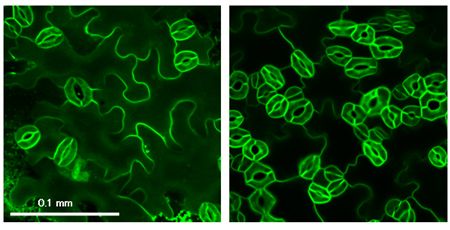March 29, 2010
Signaling Factor to Increase Stomatal Density May Contribute to Less CO2 and More Food Production
Keywords: Environmental Technology University / Research institute

Plant stoma after three-day stomagen infusion (left: before, right: after)
Copyright Kyoto University
Professor Hara-Nishimura and her research team at the Graduate School of Science, Kyoto University, announced in December, 2009 that they had discovered a signaling factor to help increase the number of plant stoma. This marked the first discovery of its kind in the world. By combining two words of "stoma" and "generation," the team termed the factor "stomagen."
Stoma, a microscopic mouth-shaped pore on the surface of a plant leaf, acts as a valve for absorbing carbon dioxide to produce starch, oil, and other materials. The team found a link between the amount of stomagen and stomatal density. Specifically, plants with additional stomagen made more stomata, whereas plants with less stomagen made fewer stomata.
The team also found that soaking seedlings in an agent with chemically synthesized stomagen for three days remarkably improved stomatal development. The attached photo on the left shows a plant's stomata without additional stomagen, while the other shows the plant's stomata three days after stomagen infusion. This is the world's first case in which scientists specifically regulated stomatal development by infusing a particular substance, rather than through genetic modification.
Stomagen is a general signaling factor found in various plants from weeds, crops, to trees, and it is also referred to as plants' peptide hormone. As this finding suggests, utilizing stomagen to positively regulate stomatal density will enable scientists to improve various kinds of plants' ability to absorb CO2 without genetic modification. With increased CO2 absorbance, increased production volume of starch, oil, and other materials will be realized. This is in turn expected to substantially contribute to dealing with food-shortage challenges due to global population growth.
Posted: 2010/03/29 06:00:15 AM
Related
"JFS Newsletter"
Related
"Popular Articles"
- New Nano-Bubble Technology May Help Dissolve Sludge and Improve Water Quality
- Japanese Firm Begins Development of Tidal Power Generation System
- Small Hydropower Generation System Developed for Use in Seawater, Weight Cut by Half
- Constructed Wetland Facility Established by Japanese University Purifies Livestock Farming Drainage
- Toyota CRDL Succeeds in World's First Artificial Photosynthesis Using only Water and CO2


